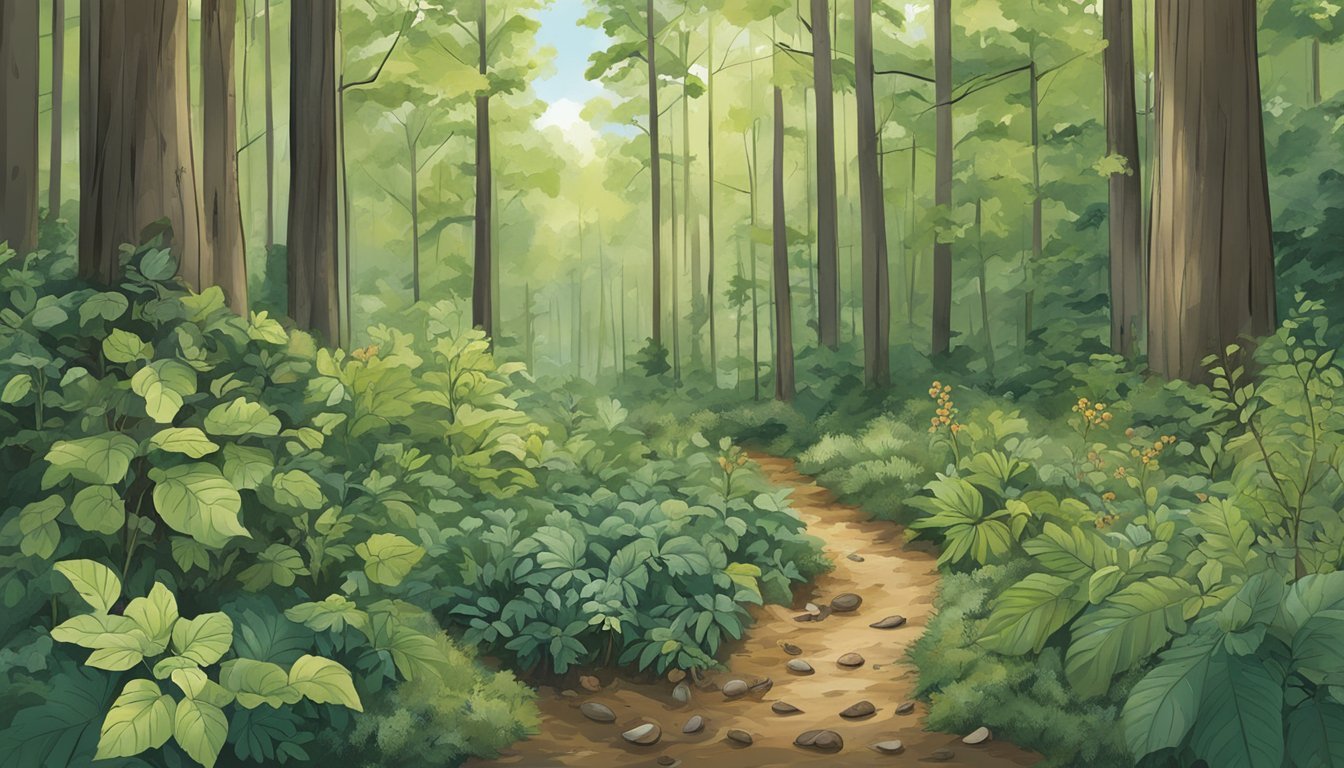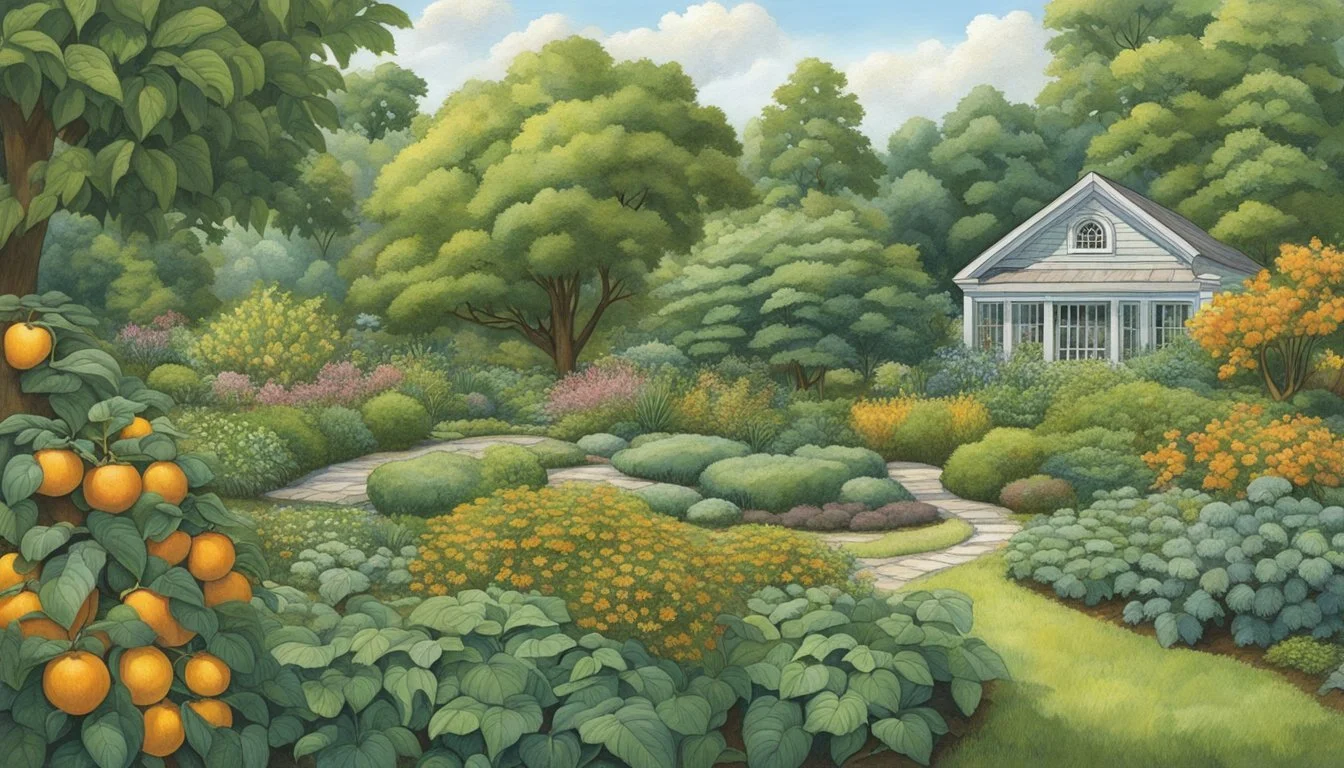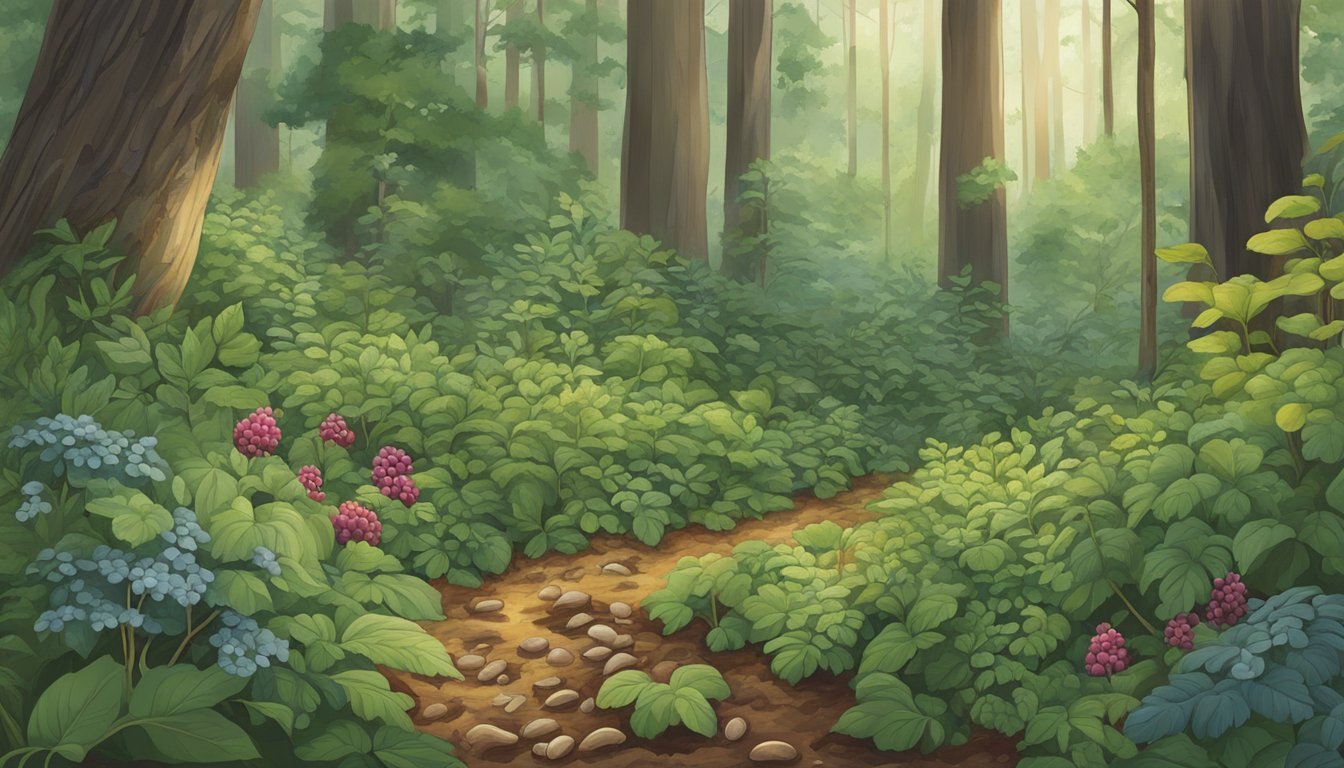Native Edible Plants in Virginia
A Guide to Foraging and Cuisine
This Article is Part of Foraging Guide for All 50 US States
Virginia's lush landscapes are a treasure trove of biodiversity, home to a vast array of native edible plants. For centuries, these plants have served as a source of nourishment for both indigenous peoples and modern foragers. The state's diverse ecosystems, ranging from the Appalachian Mountains to the coastal plains, provide a unique environment where various edible species thrive.
Among these native species are plants like Pawpaw, known for its custard-like fruit, and the American Persimmon, which produces sweet, berry-flavored fruits. The richness of the region's flora also includes numerous berry-producing shrubs, such as various species of wild blueberries (Vaccinium spp.) and the aromatic spicebush (Lindera benzoin), whose berries can be used as a spice. These plants not only offer flavors that are deeply entwined with the culinary heritage of Virginia but also support local wildlife and contribute to the ecological health of their habitats.
The study and utilization of Virginia's edible native plants are not only of gastronomic interest but also underscore the importance of conserving these species and their natural environments. By understanding the traditional uses and benefits of these plants, one gains a deeper appreciation for the region's natural history and the role these species play in sustainable ecological interactions. As such, these plants represent a vibrant part of Virginia's natural heritage and offer a unique opportunity to engage with the ecosystem through responsible foraging and cultural learning.
Interested in Mushroom Hunting in Virginia?
Virginia's diverse landscapes, from the Appalachian Mountains to the coastal plains, provide excellent habitat for a variety of edible mushrooms. Morels, chanterelles, oyster mushrooms, and chicken of the woods are among the most sought-after species in the state. The best time to hunt for mushrooms in Virginia depends on the species and location, but generally falls between spring and fall. Popular foraging spots include Shenandoah National Park and the George Washington and Jefferson National Forests. As with any mushroom hunting adventure, proper identification skills and respect for private property and conservation areas are essential for a safe and enjoyable experience in Virginia's beautiful natural areas.
👉 Guide on Mushroom Hunting in Virginia
Understanding Native Edible Plants
Recognizing the diversity and significance of native edible plants in Virginia is essential for both historical and contemporary reasons. These plants offer rich flavors and health benefits and have sustained human populations and wildlife for centuries.
Historical Context and Benefits
Native edible plants have been an integral part of Virginia's heritage. Indigenous peoples gathered and cultivated these plants for sustenance and medicine. Food sources from the natural environment played a critical role in their daily life. Today, these plants offer both economic benefits through their use in local cuisines, and ecological advantages by perpetuating traditional landscaping methods that support the environment.
Botanical Characteristics
The botanical characteristics of these edible plants vary widely. Leaves, bark, petals, and other edible parts are utilized from species that can range from herbaceous groundcovers to towering trees. The botanical diversity ensures that a myriad of species are available for foraging.
Habitat and Ecosystems
Native edible plants in Virginia thrive in a variety of habitats. Many require full sun while others flourish in partial shade or along stream banks where moisture levels are high. Their growth supports local wildlife, contributing to a balanced ecosystem. These plants are often adapted to the specific soil and climate conditions of their natural habitats, making them resilient and less reliant on human intervention for growth and productivity.
Edible Plant Seasons
The availability of native edible plants fluctuates with the seasons. Some are abundant in summer, others in fall. Seasonal foraging can yield a range of flavors and nutritional profiles, as different plants reach their peak edibility at different times of the year. Tracking these patterns allows for sustainable harvesting that does not overburden the natural ecosystem.
Plant Cultivars and Varieties
Over time, enthusiasts and professionals alike have developed various cultivars and varieties of native edible plants to enhance certain desirable traits such as taste, size, and hardiness. These cultivated versions often bear the common names of their wild counterparts, but may differ in appearance and growth characteristics. It is important to note that while cultivars can provide more controlled conditions for consumption, wild varieties are valued for their natural genetic diversity and resilience.
Identifying Edible Plants
Foraging for edible plants in Virginia requires knowledge of specific characteristics to ensure safe and fruitful gathering. This section provides guidance on identifying edible plants including trees, berries, herbaceous plants, and more.
Trees with Edible Parts
Identification: Look for leaf shapes and bark textures characteristic of edible species.
Black Walnut: Jagged leaflets; dark, furrowed bark; produces round, hard-shelled nuts (how long do nuts last?).
Hazelnut: Rounded leaves with toothed margins; nuts enclosed in a leafy bract.
Shagbark Hickory: Distinct shaggy bark; compound leaves; nuts with thick husks.
Forage Tips:
Harvest nuts when they fall to the ground.
Use gloves to handle black walnuts (how long do walnuts last?) as they stain.
Common Berries and Fruits
Identification: Observe the shape, size, and color of berries and fruits.
Pawpaw: Large, green fruit turning yellow-brown; custard-like taste.
Persimmon: Orange, globular fruit; sweet when fully ripe.
Forage Tips:
Ripe berries can be handpicked ensuring that they separate easily from the stem.
Taste test a tiny amount to ensure proper identification and ripeness.
Herbaceous Plants and Roots
Identification: Examine the plants' leaves, flowers, and root structures.
Ramps: Broad, smooth leaves; distinct garlic-onion scent.
Wild Ferns: Feather-like leaves; fiddleheads harvested before they uncurl.
Forage Tips:
Ramps should be dug out carefully, preserving the bulbs for propagation.
Harvest fiddleheads in the early spring, when tightly coiled.
Vines and Climbing Plants
Identification: Note the vine's growth pattern and leaf configuration.
Berries such as wild grapes can often be found climbing on trees or fences with heart-shaped leaves.
Examine flowers and tendrils for unique identifiers.
Forage Tips:
Consume fruits from vines only after positive identification, as many have toxic look-alikes.
Recognizing Plant Signatures
Identification: Each plant has unique signifiers such as petal formations or scent.
Associating plant's signatures with their edibility and proper harvesting times aids in identification.
Observe and familiarize with color changes throughout the seasons for accuracy.
Forage Tips:
Keep a field guide on hand to cross-reference plant signatures while foraging.
Foraging Techniques and Ethics
Understanding the right techniques and ethical considerations is crucial when foraging edible plants in Virginia. Responsible foraging ensures sustainability and legal compliance.
Best Practices in Foraging
Foraging should be conducted with minimal impact on the environment. Foragers are advised to:
Familiarize with Local Species: Learning about native plants increases foraging success and environmental protection.
Take Only What You Need: This prevents waste and ensures plant populations can regenerate.
Respect Wildlife Habitats: Avoid disturbing animals that rely on the same plants.
Leave No Trace: Dispose of any waste properly and avoid damaging the surrounding area.
Legal Considerations and Permissions
Adherence to local laws is imperative:
Check Regulations: Foraging may be restricted or prohibited in certain areas of Virginia.
Obtain Permissions: On private property, obtain consent from landowners; on public lands, ensure compliance with specific area rules.
Harvesting and Storage Methods
Proper harvesting and storage extend the usability of foraged foods:
Harvest Wisely: Cut plants cleanly to promote regrowth and harvest only ripe specimens.
Storage: Utilize appropriate food preservation techniques, such as drying or canning to maximize the shelf life.
Avoiding Poisonous and Protected Species
Caution is vital:
Identification: Accurately identify plants to avoid poisonous species that can be harmful if consumed.
Protection Status: Be aware of protected plant species under Virginia law to prevent illegal harvesting.
Culinary Uses and Nutrition
Native edible plants of Virginia provide a wealth of culinary options and nutritional benefits.
Traditional and Modern Recipes
In both traditional and contemporary kitchens, chefs use native plants to add unique flavors and textures to their dishes. Ramps, a wild onion found in Virginia, are a popular ingredient in springtime recipes. They add a pungent, garlic-onion flavor to salads, pies, and more. Berries, such as those from the serviceberry, are commonly turned into jams, pies, and candies. Traditional recipes frequently include these ingredients, while modern chefs often reinterpret them in new, inventive dishes.
Health Benefits and Nutritional Value
Nutrition: Native edible plants of Virginia are often nutrient-dense, packed with vitamins, minerals, and antioxidants. For instance, violets, which are both decorative and edible, contain high levels of vitamin C. Berries, universally renowned for their health benefits, are rich sources of fiber and antioxidants.
Plant Nutritional Components Health Benefits Violet Vitamins A and C, Iron Immune support, skin health Serviceberry Fiber, Vitamin C, Antioxidants Digestive health, cell protection
Preparing Roots and Nuts for Consumption
When preparing plants such as roots and nuts for consumption, certain processes are required to make them safe and palatable. Black walnuts and hazelnuts must be carefully harvested and cleaned. Shagbark hickory nuts are valued for their sweet taste and are often incorporated into syrups or used to flavor a unique variety of wine. Roots like those of the ramp need to be cleaned thoroughly and can be roasted or sautéed.
Cultivating Native Edible Plants
In Virginia, cultivating native edible plants contributes to local ecosystems' health while providing gardeners with a rich source of food. For beginners and experienced home gardeners alike, the establishment of a food forest can be both attractive and rewarding.
Landscape Design with Edible Plants
Virginia's climate allows for a diverse range of native edible plants that can be incorporated into landscape design. When planning a garden, consider plants that thrive in full sun to partial shade, and arrange them so taller plants provide shade for those that require less sunlight. Common examples of native edibles perfect for a Virginia garden include:
Pawpaw: Prefers part shade and rich, moist soil.
American Persimmon: Thrives in full sun and is drought-tolerant.
Incorporating a variety of species into the garden design can help ensure year-round interest and harvest.
Propagation and Care
Effective propagation and care are vital for the cultivation of native plants. Propagation varies by species, but many can be grown from seeds or cuttings. For instance:
Plant stratified seeds in fall for species that require cold temperatures to germinate.
Softwood cuttings taken in early summer can propagate species like blueberries.
Care for these plants often involves ensuring adequate moisture levels, especially during dry spells, and managing pests without resorting to harsh chemicals that can harm local wildlife and ecosystems.
Integration in Urban Environments
Even in urban areas such as Richmond and Northern Virginia, it is feasible to cultivate native edibles. City dwellers can create small-scale food forests in their yards or community gardens, selecting plants that can adapt to more confined spaces. The City of Richmond, for instance, can serve as a model for how green spaces in urban environments contribute to community health and biodiversity. A few strategies include:
Choosing plants that serve multiple purposes, such as providing food and acting as natural pest deterrents.
Utilizing vertical space by growing vining plants on trellises.
Implementing raised beds and container gardens for better soil control and drainage.
Appendices
The Appendices provide essential supplementary materials for enthusiasts and scholars interested in Virginia's native edible plants. They encompass a glossary, a foraging guide, and a list of resources for further exploration.
Glossary of Common Names and Terms
The following table lists common names of native edible plants found throughout Virginia, including counties such as Goochland, Henrico, Chesterfield, and beyond, paired with their corresponding scientific terms to aid in accurate identification:
Common Name Scientific Name Pawpaw Asimina triloba American Persimmon Diospyros virginiana Wild Strawberry Fragaria virginiana Blackberry Rubus spp. Elderberry Sambucus canadensis
Regional Guide for Foragers
Virginia's diverse regions, from the Northern Neck to counties like New Kent, Powhatan, and Cumberland, offer a bounty of forageable plants. Here is a brief guide for foragers by region:
Northern Neck: Abundant in pawpaws and persimmons along its riverbanks.
Goochland and Henrico: Known for wild strawberries and blackberries in open fields.
Charles City and New Kent: Rich in elderberry and other berry bushes in wooded areas.
York and Bland Counties: Home to a variety of mushrooms and wild greens in their forested landscapes.
This guide is a starting point and foragers should consult local regulations and obtain necessary permissions before foraging.
References and Further Reading
For those seeking to deepen their research, the following list includes recommended encyclopedias and guides that provide extensive information on the flora of Virginia:
Edible Wild Plants: A North American Field Guide by Thomas Elias and Peter Dykeman – an encompassing resource for foragers.
A Field Guide to Medicinal Plants and Herbs of Eastern and Central North America by Steven Foster and James Duke – offers additional insights into plant uses.
Flora of Virginia – an authoritative encyclopedia detailing Virginia's plant life, including regions like Amelia, York, Washington, and Salem.
Local extension offices in counties such as Orange, Hanover, and Chesterfield often have pamphlets and resources specific to regional flora.
These resources are fundamental for anyone aiming to gain in-depth knowledge on the subject.
Conclusion
Virginia's landscape provides a diverse array of native edible plants. These species not only offer culinary benefits but also hold ecological importance. The incorporation of these plants into modern diets supports sustainable food practices and encourages biodiversity.
A Reflective Note:
Educational efforts have increased awareness about native edibles. Their cultural significance and nutritional value underscore the merit in preserving these species. Individuals and communities show growing interest in traditional foraging practices, reflective of a deeper connection to the local environment.
Future Directions:
Embracing native edibles could foster novel agricultural advancements and enhance regional cuisine diversity. Research is pivotal for understanding the full potential of these plants. Future initiatives might focus on:
Cultivation methods that respect natural habitats
Documentation of plant usage by indigenous cultures
Development of preservation techniques for rare species
With these endeavors, Virginia's native edible plants will continue to be an integral part of its cultural heritage and natural ecology.






